|
| Author |
Message |
TomChum
Member
|
# Posted: 22 Jan 2013 12:34pm - Edited by: TomChum
Reply
Anyone have pics of their instrumentation used to monitor what's happening at the battery bank? I can't imagine anyone fool enough to go my way, but even so, it's a pertinent subject for a small-cabin forum. There are LOTS of little digital meters for $10-$20 on ebay that would work perfect.
I would LIKE a digital readout and even a datalogger but held back from ordering them because I'm always compelled to make my cabin look "old". And once you let that new stuff in your cabin it won't leave. Well this weekend I was at a fleamarket in New York and thought, I wonder if anyone has old electrical meters???
Jackpot! (my kind of jackpot, anyway....) $45 - I hope they work, and if not should be easy to unload on eBay. It has a couple old switches too, I suppose they bypass the guage. I shipped it home, all I have is this pic. Last time I searched eBay it did not have as much cool old DC guages but today eBay has lots. eBay search "antique dc voltmeter" if that's what you like too.
The voltmeter is 150vDC, if I can divide by 10 to get 15.0volts that will be perfect. My solar panels put out maybe 15A, but the charger goes up to 57A, so the 75A DC ammeter is perfect. I'm in heaven. OTOH this is bad news for a scrounger, such a find makes me scrounge even more. My wife is afraid, very afraid.
Does anyone know how to tell what year these guages were made?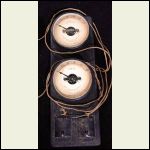
Antique Voltmeter Ammeter
|  |  |  |
|
|
MtnDon
Member
|
# Posted: 22 Jan 2013 01:21pm - Edited by: MtnDon
Reply
There are meters that can be used much like a fuel level gauge in a motor vehicle. Bogart engineering makes the best, IMO. They do need to be calibration and as the batteries age recalibration is also needed. Most other meters that sell for considerably less are no better than a digital multimeter, IMO. Digital beats analog by a mile as well. A few tenths of a volt make quite a difference on a 12 volt system.
I use the Outback Mate as a control and programming aid to our Outback system. It does provide a voltage reading and some basic logged info. But volts alone are only an aid, not a real indication of how each battery or each cell is doing. I use a hydrometer with a thermometer. Similar to this one as my main tool. And a notebook to record the readings for each cell.
|
|
TomChum
Member
|
# Posted: 25 Jan 2013 10:06am - Edited by: TomChum
Reply
Quoting: MtnDon IMO. Digital beats analog by a mile as well.
Yes I agree. I may have to hide one somewhere  Will be interesting to see what instrumentation folks are using. Will be interesting to see what instrumentation folks are using.
|
|
exsailor
Member
|
# Posted: 25 Jan 2013 12:57pm
Reply
Judging by the cloth insulation covering on the wires, They may have been made as early as the 30's and on into the early 50's.
|
|
MtnDon
Member
|
# Posted: 25 Jan 2013 01:02pm
Reply
Quoting: TomChum I may have to hide one somewhere Will be interesting to see what instrumentation folks are using.
Stick modern stuff in a cupboard.
I'll wager most folks have nothing much at all.
|
|
GomerPile
Member
|
# Posted: 25 Jan 2013 01:12pm
Reply
http://www.xantrex.com/power-products/power-accessories/linklite-battery-monitor.aspx
Can be had for less than $200 if you poke around.
|
|
Dillio187
Member
|
# Posted: 25 Jan 2013 08:16pm - Edited by: Dillio187
Reply
I use the prior mentioned Bogart Engineering Trimetric 2025. It uses a shunt to measure current in and out of my battery banks, and works well! In these pictures you can see I'm drawing 21 amps from my bank, which is at 12.5 volts with 99% remaining.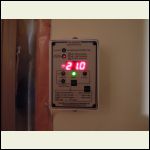
amps.jpg
| 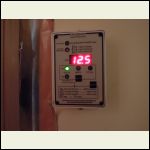
battvoltage.jpg
| 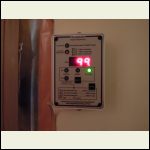
percent.jpg
| 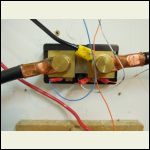
shunt.jpg
|
|
|
TomChum
Member
|
# Posted: 26 Jan 2013 09:45pm - Edited by: TomChum
Reply
Thats pretty cool Dillio. All I know is the voltage, when it drops to 12.4, I start the generator. I'm gonna get something like that.
|
|
|
Moving Pictures
Member
|
# Posted: 28 Jan 2013 05:25pm
Reply
Quoting: TomChum Dillio. All I know is the voltage, when it drops to 12.4, I start the generator. I'm gonna get something like that.
If there is a load, the voltage reading will be misleading to some - if not a great - degree.
Yesterday, the panels pushed 1.2 kw/hr into the batteries. I had a crock pot and the fridge plugged in - and when both of those were on the circuit, the terminal voltage dropped to 12.0 volts - but the batteries had just been on absorb, about to go to float, a minute earlier.
A voltage reading will only be a reasonably accurate measure of charge under a few circumstances, one of which is the water levels/specific gravity being reasonable, and all loads/charging sources removed from the battery for a goodly time - several hours.
Alternately, I had an old gel-cel donated to me. I charged it two weeks ago. it has a voltage right now of 12.2 volts - but it's deader than a doornail: it "charged" from 11.4v to 13 in about an hour, drawing maybe 8 amp-hours in that time. It's a 160 amp-hour battery ... should have taken days to charge at that rate.
|
|
TomChum
Member
|
# Posted: 28 Jan 2013 07:48pm - Edited by: TomChum
Reply
I should have clarified that "when the at-rest voltage drops to 12.4v" I start the generator. At 12.5 & above, I let the solar panels take care of it.
By "at-rest" I mean when it's dark (=no input from sunlight), and there's been only a minimal draw on the batteries from a couple LED lights (less than 10 watts total). A true "at-rest" situation would be early morning, when there's been NO input or output on the batteries for several hours.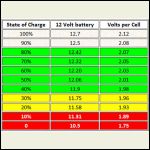
Chart to estimate percent of charge on deep cycle (Golf cart) batteries Flooded lead-acid.
|  |  |  |
|
|
Dillio187
Member
|
# Posted: 28 Jan 2013 09:30pm
Reply
yea, it takes a few hours for the battery to normalize after loads or chargers are disconnected. That's why I love the Trimetric so much, and for less than $200 for the meter and shunt, it's a no brainer.
|
|
Moving Pictures
Member
|
# Posted: 28 Jan 2013 10:43pm
Reply
Tom - I'm still getting used to the solar panels and batteries in our test situation (living room off grid in advance of going totally off-grid in two-three years - so we screw up now when it doesn't matter and learn less painfully). I'd think that you could go beyond 80 per cent DOD without growing squeamish ... but I'd like to hear your logic/reasoning for your current protocol.
|
|
CabinBuilder
Admin
|
# Posted: 29 Jan 2013 11:02am - Edited by: CabinBuilder
Reply
Quoting: TomChum I'm using this to determine percent of charge
I assume the table is for flooded lead-acid batteries.
As far as I know, the AGM and Gel batteries have different voltages for their charge levels. Correct?
If yes, then (electronic) battery charge controllers and level monitors should be different for each battery type, or have a setting where you can specify the battery type they're connected to.
I haven't seen this distinction in charges and monitors' specs, no mater how 'smart' they are. 
Am I missing something?
Also, to my knowledge, different types of batteries have different optimal charging regimes. For example, only lead-acid type have the equalization phase. Therefore a real 'smart' charger should take into account that difference.
|
|
TomChum
Member
|
# Posted: 29 Jan 2013 12:19pm
Reply
When you start out, the other parts of the system seem more important than the instrumentation. Panels, their placement and mounting, cables, batteries, battery box, inverters, generators, chargers. At some point you WANT to know what's going on, and how to extend the life of your batteries. Then instrumentation becomes more interesting.
From what I've read, if you keep your batteries in their top 90% they will last the longest. Getting more years costs time and effort up front, so my current thought is that 80% is pretty good. Even when it's cloudy I can keep them in the top 80%, running the generator once every couple days.
|
|
MtnDon
Member
|
# Posted: 29 Jan 2013 01:30pm
Reply
The recommended charge rates (bulk, absorb and float) vary from one brand of AGM to another. And many times the AGM require a different rate than flooded lead-acid. The AGM are more sensitive to overcharging than flooded lead-acid. That is because when a flooded battery is overcharged and the electrolyte level falls it is a simple matter to add water (distilled preferred). When an AGM battery is overcharged the gases may be vented off through the regulator valve. That's bad news as the fluid can not be replaced.
Before buying any AGM it is my opinion a person should also research the various chargers. That applies to a charge controller for a PV system, the charger section of an inverter/charger unit and stand alone battery chargers. Many cheaper chargers may have a charge rate that is incompatible with certain batteries. Incompatible in the sense that the battery life may be shortened. The batteries will be charged and seem okay until they fail.
The upper scale chargers, charge controllers and inverter/chargers are programmable. The user can adjust the charge points in increments of 1/10 of a volt in the best ones. As AGM batteries cost more in the first place it is unwise, IMO, to buy them and go cheap on the electronics.
Stand alone chargers never have a temperature sensor; at least I have never seen one. The charge requirements change slightly as temperatures wander below or above 77 F. A better to best quality charge controller and inverter/charger either come with or have an optional sensor. Those units will automatically vary their output. Very handy as excessive temperature will also shorten a battery life; flooded or AGM.
I agree that instrumentation of the Trimetric variety is not a necessary piece of equipment for any people. I'd recommend putting money into better quality charger controllers or inverter/charger and a hydrometer (assuming you buy flooded batteries) before buying special instruments. Instruments like the Trimetric can be added with relative ease at any later date. Adding is even easier if in the planning stages the user studies up on the wiring required for the instrument and builds in some right at the start.
Flooded lead acid batteries like golf cart and the larger industrial and renewable energy batteries take more abuse and because of that, IMO, are a better value for most people. Flooded lead-acid batteries have another big advantage, IMO. The user can use a hydrometer to monitor the sp gr of the electrolyte. You can not do that with AGM. A hydrometer is the most accurate method when combined with a thermometer and a correction chart. Ten dollars and a notebook to record the cell reading provides a history.
AGM's do have some advantages too so we all have to make a choice. But study up on all the details, all the components before ordering parts.
I aim for maz 75% DOD
|
|
creeky
Member
|
# Posted: 29 Jan 2013 04:25pm
Reply
I use a web connection to my controller, the morningstar mppt. I ran a rj-45 cable from the controller to my router. easy, as they are in the same room. In my web browser I then typed in ts+serial number and up came a complete 209 day data log / history. a separate window provides a "live view". Including battery temp, charge levels, even what my panels are doing.
I don't recommend this route ;) as it's completely addictive. annoy wives and baffle strangers with esoteric knowledge of your solar system.
Although I don't have one: The trimetric has the benefit of giving you a % battery power remaining (thanks for the pics Dillio187). That's a nice feature. If you went by the 12.5 voltage you could think your batteries were at 80%. While in fact it's the load that is pushing the batteries down to 12.5 (as others have mentioned).
By way of an example. I'll see maybe 12.5 in the morning on my data log. Then I run the kettle. The battery "low" display will now show 12 (actually 11.97 is the usual low for kettle use).
Getting a .0x reading is a bit obsessive. My batteries aren't currently at 13.4, on the web page they're actually 13.42.
I've let my batteries go to 12.3 "at rest." I probably should go more 12.4, but I hate running the genny.
|
|
|

